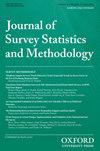利用概率调查数据中的辅助信息改进非概率样本的伪加权:一种Copula模型方法
IF 1.6
4区 数学
Q2 SOCIAL SCIENCES, MATHEMATICAL METHODS
引用次数: 0
摘要
摘要概率抽样一直被认为是调查方法的金标准,而非概率抽样因其方便和低成本而越来越受欢迎。然而,由于潜在选择机制的未知性质,非概率样本可能导致有偏差的估计。在本文中,我们提出了参数和半参数的方法来整合概率和非概率样本,使用在两个样本中观察到的共同辅助变量。在参数化方法中,假设辅助变量的联合分布遵循隐高斯copula模型,该模型可以灵活地容纳分类变量和连续变量。相反,半参数方法不需要对辅助变量的分布作任何假设。此外,采用逻辑回归对总体单元进入非概率样本的机制进行了建模。利用伪极大似然方法对copula模型中的未知参数进行估计。逻辑回归模型是通过使非概率样本构造的样本似然最大化来估计的。在估计总体均值的背景下对所提出的方法进行了评估。仿真结果表明,该方法能够通过一致地估计潜在的包含机制来纠正非概率样本中的选择偏差。通过在非概率样本中加入附加信息,该组合方法可以比单独使用概率样本更有效地估计总体均值。给出了一个实际数据应用,说明了该方法的实际应用。本文章由计算机程序翻译,如有差异,请以英文原文为准。
Using Auxiliary Information in Probability Survey Data to Improve Pseudo-Weighting in Nonprobability Samples: A Copula Model Approach
Abstract While probability sampling has been considered the gold standard of survey methods, nonprobability sampling is increasingly popular due to its convenience and low cost. However, nonprobability samples can lead to biased estimates due to the unknown nature of the underlying selection mechanism. In this article, we propose parametric and semiparametric approaches to integrate probability and nonprobability samples using common ancillary variables observed in both samples. In the parametric approach, the joint distribution of ancillary variables is assumed to follow the latent Gaussian copula model, which is flexible to accommodate both categorical and continuous variables. In contrast, the semiparametric approach requires no assumptions about the distribution of ancillary variables. In addition, logistic regression is used to model the mechanism by which population units enter the nonprobability sample. The unknown parameters in the copula model are estimated through the pseudo maximum likelihood approach. The logistic regression model is estimated by maximizing the sample likelihood constructed from the nonprobability sample. The proposed method is evaluated in the context of estimating the population mean. Our simulation results show that the proposed method is able to correct the selection bias in the nonprobability sample by consistently estimating the underlying inclusion mechanism. By incorporating additional information in the nonprobability sample, the combined method can estimate the population mean more efficiently than using the probability sample alone. A real-data application is provided to illustrate the practical use of the proposed method.
求助全文
通过发布文献求助,成功后即可免费获取论文全文。
去求助
来源期刊
CiteScore
4.30
自引率
9.50%
发文量
40
期刊介绍:
The Journal of Survey Statistics and Methodology, sponsored by AAPOR and the American Statistical Association, began publishing in 2013. Its objective is to publish cutting edge scholarly articles on statistical and methodological issues for sample surveys, censuses, administrative record systems, and other related data. It aims to be the flagship journal for research on survey statistics and methodology. Topics of interest include survey sample design, statistical inference, nonresponse, measurement error, the effects of modes of data collection, paradata and responsive survey design, combining data from multiple sources, record linkage, disclosure limitation, and other issues in survey statistics and methodology. The journal publishes both theoretical and applied papers, provided the theory is motivated by an important applied problem and the applied papers report on research that contributes generalizable knowledge to the field. Review papers are also welcomed. Papers on a broad range of surveys are encouraged, including (but not limited to) surveys concerning business, economics, marketing research, social science, environment, epidemiology, biostatistics and official statistics. The journal has three sections. The Survey Statistics section presents papers on innovative sampling procedures, imputation, weighting, measures of uncertainty, small area inference, new methods of analysis, and other statistical issues related to surveys. The Survey Methodology section presents papers that focus on methodological research, including methodological experiments, methods of data collection and use of paradata. The Applications section contains papers involving innovative applications of methods and providing practical contributions and guidance, and/or significant new findings.

 求助内容:
求助内容: 应助结果提醒方式:
应助结果提醒方式:


